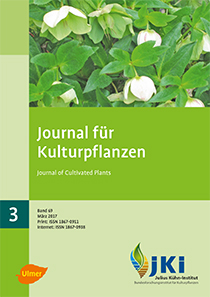Ammonium toxicity – one cause for growth and quality impairments on organic fertilized basil?
Keywords:
Ocimum basilicum L., organic nitrogen fertilization, ammonium/nitrate ratio, ammonium toxicity, chlorotic cotyledonsAbstract
In the organic production of pot grown basil yield depressions and quality impairments are often observed. During the early development stage cotyledons become chlorotic and necrotic. Subsequently, infections with secondary parasites such as Botrytis may occur. One possible reason for this problem could be the high concentration of ammonium in the growing media released by the mineralization of organic fertilizers. Therefore, a fertilization trial was carried out including different ammonium-N/nitrate-N ratios (100/0; 50/50; 0/100) and nitrogen concentrations in the nutrient solution (8, 12 and 16 mmol N/L). Plants were cultivated in a peat substrate and fertilized by using the ebb and flow technique. The applied nutrient solution contained, beside the different nitrogen sources, equal concentrations of a base fertilizer as well as the nitrification inhibitor 3,4-dimethylpyrazolephosphate (DMPP). In addition an organic fertilization treatment was realized using a solid base dressing (horn shavings and DCM ECO-MIX 4) and a liquid top dressing (Organic Plant Feed). The plants were cultivated in a peat substrate which was adjusted to an initial pH of 6.5.
Basil fertilized solely with ammonium (NH4+) showed a diminished growth in comparison to well-developed plants receiving nitrate (NO3-) as nitrogen source. Germination rate, plant height and fresh matter yield of herbs were significantly reduced by NH4+ nutrition. Furthermore, chlorotic cotyledons and a reduction in turgidity of the shoot could be observed. Growth of plants receiving organic nitrogen initially also remained behind the NO3- treatment. Furthermore, with this nitrogen source cotyledons were most strongly affected by chlorosis, probably because the NH4+ concentration in the substrate rose up to 350 mg N/L at the beginning of the cultivation period. When nitrogen mineralization declined and NH4+ was increasingly converted to NO3-, plants exhibited improved growth. At the end of the experiment the NO3- content in basil shoots was highest in the organic N treatment. The most compact growth and the highest turgidity of plants were observed with balanced supply of NO3- and NH4+.
DOI: 10.1399/JfK.2017.03.02, https://doi.org/10.1399/JfK.2017.03.02








